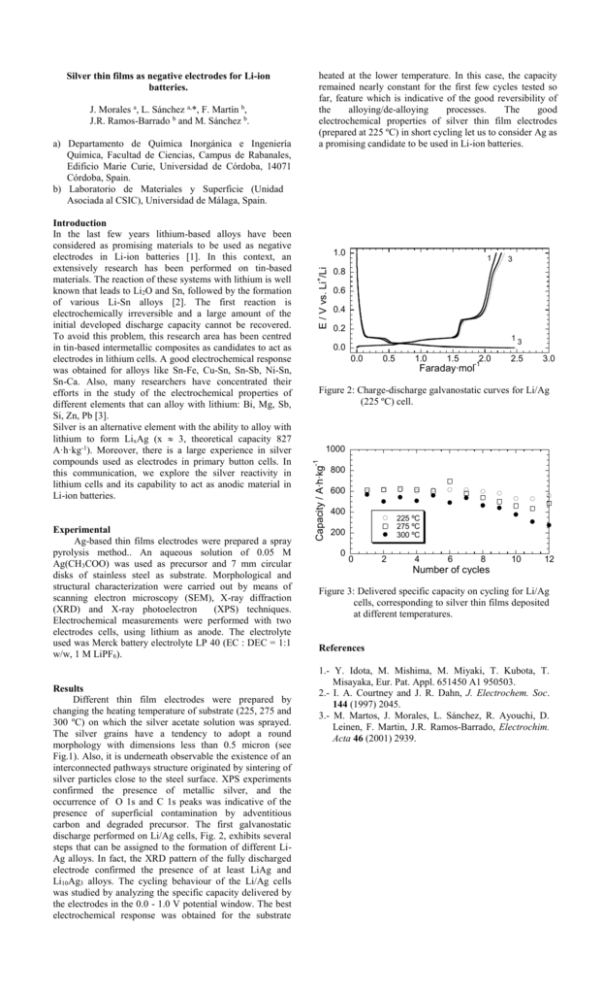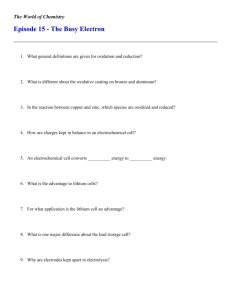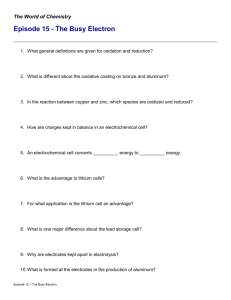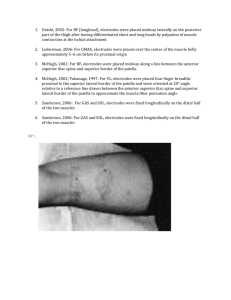Silver thin films as negative electrodes for Li
advertisement

Experimental Ag-based thin films electrodes were prepared a spray pyrolysis method.. An aqueous solution of 0.05 M Ag(CH3COO) was used as precursor and 7 mm circular disks of stainless steel as substrate. Morphological and structural characterization were carried out by means of scanning electron microscopy (SEM), X-ray diffraction (XRD) and X-ray photoelectron (XPS) techniques. Electrochemical measurements were performed with two electrodes cells, using lithium as anode. The electrolyte used was Merck battery electrolyte LP 40 (EC : DEC = 1:1 w/w, 1 M LiPF6). Results Different thin film electrodes were prepared by changing the heating temperature of substrate (225, 275 and 300 ºC) on which the silver acetate solution was sprayed. The silver grains have a tendency to adopt a round morphology with dimensions less than 0.5 micron (see Fig.1). Also, it is underneath observable the existence of an interconnected pathways structure originated by sintering of silver particles close to the steel surface. XPS experiments confirmed the presence of metallic silver, and the occurrence of O 1s and C 1s peaks was indicative of the presence of superficial contamination by adventitious carbon and degraded precursor. The first galvanostatic discharge performed on Li/Ag cells, Fig. 2, exhibits several steps that can be assigned to the formation of different LiAg alloys. In fact, the XRD pattern of the fully discharged electrode confirmed the presence of at least LiAg and Li10Ag3 alloys. The cycling behaviour of the Li/Ag cells was studied by analyzing the specific capacity delivered by the electrodes in the 0.0 - 1.0 V potential window. The best electrochemical response was obtained for the substrate 1.0 1 3 0.8 + Introduction In the last few years lithium-based alloys have been considered as promising materials to be used as negative electrodes in Li-ion batteries [1]. In this context, an extensively research has been performed on tin-based materials. The reaction of these systems with lithium is well known that leads to Li2O and Sn, followed by the formation of various Li-Sn alloys [2]. The first reaction is electrochemically irreversible and a large amount of the initial developed discharge capacity cannot be recovered. To avoid this problem, this research area has been centred in tin-based intermetallic composites as candidates to act as electrodes in lithium cells. A good electrochemical response was obtained for alloys like Sn-Fe, Cu-Sn, Sn-Sb, Ni-Sn, Sn-Ca. Also, many researchers have concentrated their efforts in the study of the electrochemical properties of different elements that can alloy with lithium: Bi, Mg, Sb, Si, Zn, Pb [3]. Silver is an alternative element with the ability to alloy with lithium to form LixAg (x 3, theoretical capacity 827 A·h·kg-1). Moreover, there is a large experience in silver compounds used as electrodes in primary button cells. In this communication, we explore the silver reactivity in lithium cells and its capability to act as anodic material in Li-ion batteries. E / V vs. Li /Li a) Departamento de Química Inorgánica e Ingeniería Química, Facultad de Ciencias, Campus de Rabanales, Edificio Marie Curie, Universidad de Córdoba, 14071 Córdoba, Spain. b) Laboratorio de Materiales y Superficie (Unidad Asociada al CSIC), Universidad de Málaga, Spain. 0.6 0.4 0.2 13 0.0 0.0 0.5 1.0 1.5 2.0 -1 Faraday∙mol 2.5 3.0 Figure 2: Charge-discharge galvanostatic curves for Li/Ag (225 ºC) cell. 1000 -1 J. Morales a, L. Sánchez a,*, F. Martín b, J.R. Ramos-Barrado b and M. Sánchez b. heated at the lower temperature. In this case, the capacity remained nearly constant for the first few cycles tested so far, feature which is indicative of the good reversibility of the alloying/de-alloying processes. The good electrochemical properties of silver thin film electrodes (prepared at 225 ºC) in short cycling let us to consider Ag as a promising candidate to be used in Li-ion batteries. Capacity / A∙h∙kg Silver thin films as negative electrodes for Li-ion batteries. 800 600 400 225 ºC 275 ºC 300 ºC 200 0 0 2 4 6 8 10 12 Number of cycles Figure 3: Delivered specific capacity on cycling for Li/Ag cells, corresponding to silver thin films deposited at different temperatures. References 1.- Y. Idota, M. Mishima, M. Miyaki, T. Kubota, T. Misayaka, Eur. Pat. Appl. 651450 A1 950503. 2.- I. A. Courtney and J. R. Dahn, J. Electrochem. Soc. 144 (1997) 2045. 3.- M. Martos, J. Morales, L. Sánchez, R. Ayouchi, D. Leinen, F. Martin, J.R. Ramos-Barrado, Electrochim. Acta 46 (2001) 2939.





